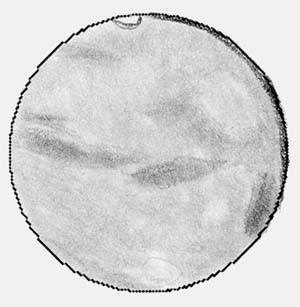
Sketched September 18, 2003 from my back deck in San Rafael, CA at 12:10 a.m. pacific DST (daylight savings time) or 07:10 UT September 18. Seeing deteriorating, but ok, transparency LM 4.0.
| Date: 09/18/03 Lat 37N, Long 122W, elev. 200 feet | Sketch Time (UT): 7:10, (local time): 12:10 a.m. DST |
| Central Meridian: 247° | Filters: #82A, #80, #21, #25, #11 |
| Instrument: 4-inch (105mm) f/6 Astro-Physics Traveler Apo refractor. | Distance from earth 0.41 AU, 61.5m km, 38.1m miles |
| Magnification: (4mm) 376x Zeiss Abbe Ortho combined with a 2.4x AP Barcon Barlow | Transp. 4/6, Seeing 6/10, Antoniadi (I-V): II |
| Apparent Size: 23" | Magnitude: -2.5 |
Details about Mars: Diameter 23 arc seconds (Jupiter is about 30 -50 arc seconds in diameter depending on its distance from earth). Central Meridian 247 - the imaginary line passing through the planetary poles of rotation and bisecting the planetary disk, and is used to determine the longitude during an observing session.
The terminator, where daylight ends and evening begins on Mars is back! The terminator is now on the right and the planet is rotating left to right. In my sketches, the planet rotates Martian east to Martian west to match most other images and sketches. The terminator is on the other side of the disk as we have passed opposition and Mars' phase is now 98.6%.
Mare Sirenum and Mare Cimmerium are rotating off the disk, on the left in my sketch. Above, between this and the shrinking south polar cap is a dark feature - Mare Chronium. Some charts call it Phaethontis. Eridania, a lighter area is sort of shown in my sketch just above where Mare Sirenum and Mare Cimmerium intersect. I think Electris is the dark streak below this lighter feature in my sketch. To the right of this lighter area is Hellas which has fully rotated on to the visible disk on the right or eastern or terminator side. One fascinating feature I watch rotate on was Libya. As I watched for the appearance of dark Syrtis Major, for an hour all I saw was a white spot rotate on. Finally Syrtis Major became visible, as you can see on this final sketch of this session. Down by the north polar area, a white feature, Chaos is visible, easier to see using the blue #80A and #82A filters. Filters: I tried all my filters tonight. The #82A light blue filter made Hellas appear almost white, and helped me see the tiny south polar cap better. The 80A blue filter also made the light features stand out. Both of these filters made Libya visible as it rotated on near the terminator.

White Oaks Home | Sketches Index | Mars 2003 Index | Back | Next